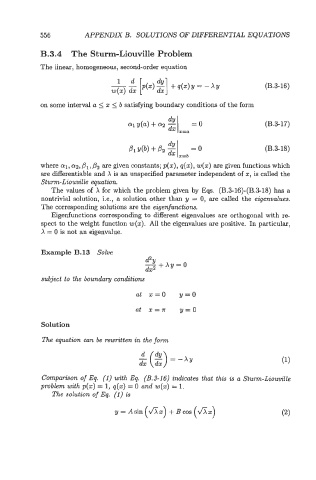Page 576 - Modelling in Transport Phenomena A Conceptual Approach
P. 576
556 APPENDIX B. SOLUTIONS OF DIFFERENTIAL EQUATIONS
B.3.4 The Sturm-Liouville Problem
The linear, homogeneous, second-order equation
-2-2 [.(.,SI +q(x)y=-Xy
w(x) dx (B.3-16)
on some interval a 5 x 5 b satisfying boundary conditions of the form
(B.3- 17)
(B.3-18)
where cy1, cyz, pl, pz are given constants; p(x), q(x), w(x) are given functions which
are differentiable and X is an unspecified parameter independent of x, is called the
Stum-Liouwille equation.
The values of X for which the problem given by Eqs. (B.3-16)-(B.3-18) has a
nontrivial solution, i.e., a solution other than y = 0, are called the eigenvalues.
The corresponding solutions are the eigenfinctions.
Eigenfunctions corresponding to different eigenvalues are orthogonal with rc
spect to the weight function w(x). All the eigenvalues are positive. In particular,
X = 0 is not an eigenvalue.
Example B.13 Solve
d%
p+Xy=O
subject to the boundary conditions
at x=O y=O
at X=?T y=O
Solution
The equation can be -written in the form
Comparison of Eq. (1) with Eq. (B.3-16) indicates that this is a Sturm-Liouville
problem with p(x) = 1, q(x) = 0 and w(x) = 1.
The solution of Eq. (1) is
y = Asin (ax) + BCOS (fix)

